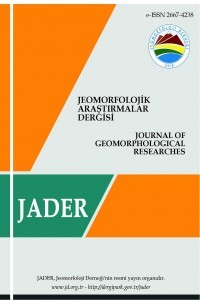
Jeomorfolojik Araştırmalar Dergisi
Yazarlar: Ahmet Serdar AYTAÇ, Tuncer DEMİR
Konular:Fiziki Coğrafya
DOI:10.46453/jader.808847
Anahtar Kelimeler:Gediz,Subaqueous Volcanism,Pillow Lava,Kula - Salihli Geopark,Aegean Region of Turkey
Özet: Most volcanism on Earth occurs beneath the oceans, but underwater volcanoes are difficult to study. So the number of studies that are related to submarine volcanism are limited. Recent advances in the study of geomorphology of sea floor have revealed up an unprecedented view of mystery on the seabed. Many submarine volcanoes are located near areas of tectonic plate formation, known as mid-ocean ridges. The volcanoes at mid-ocean ridges alone are estimated to account for 75% of the magma output on Earth. Although most submarine volcanoes are located in the depths of seas and oceans, some also exist in shallow water of seas and lakes. Although the formation processes, products and emerging shapes of terrestrial volcanism are well known, our knowledge about submarine or underwater volcanism is quite new and pretty insufficient. The main reason for this is that many processes related to underwater volcanism cannot easily be observed. Until recently, an important oart of our knowledge was obtained by interpreting traces of past volcanisms. In this regard, the Kula volcanic region contains some important historical evidence of both terrestrial volcanism as well as underwater volcanism even if it occurred in a limited area. This study aims to investigate geomorphological evidence of the occurence of a volcanism taken place underwater in an Early Pleistocene lava dam lake in the Paleo Gediz Valley in the Kula volcanic region. In this study, we benefited from the results of datas and observations of our geomorphological projects that have been carried out in the region for many years. The age data of various stratigraphic units and lavas were obtained from the age analysis of the projects in question or from the relavent literature on the field.The findings reveal that Kartepe is in fact a typical volcanic chimney or a cone which was formed as a volcano erupted out of the Miocene sedimentary units common in the region. Kartepe volcanism took place in two phases, initially it erupted close to the Paleo-Gediz valley and partly burried the Terrace VI of Paleo-Gediz. The second phase took place in the lake formed as a result of eruption of Akçeme volcano blocking the Gediz River in downstream reach. It was found that the lava errupted in this second phase turned into pillow lava by directly contacting with water.